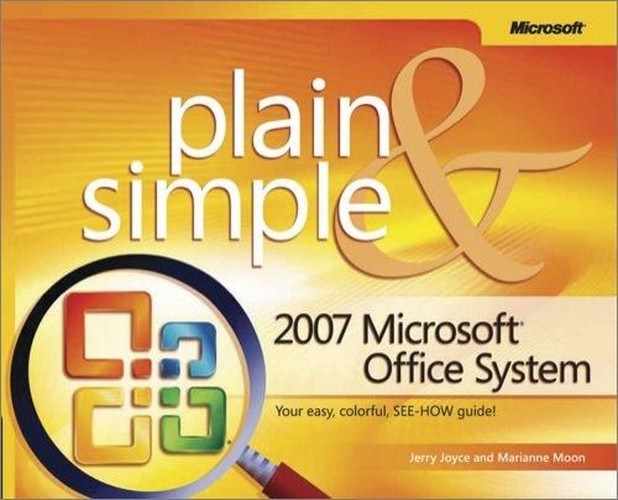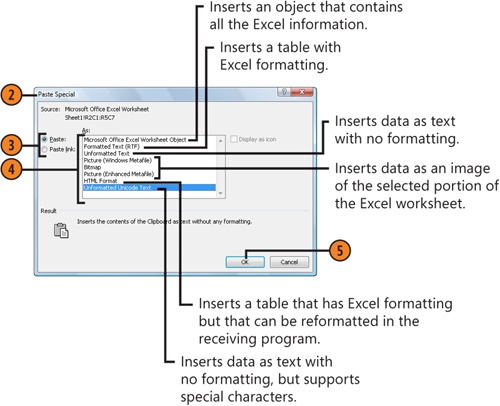Each of the programs in the 2007 Microsoft Office System was designed to do a specific job, and to do it superbly. However, there are times when the interoperability of the programs—that is, the way they work together to enhance each other’s performance—can give you even better results than using a single program. And, because of the similarities in structure and functionality among most of the Office programs, working with more than one program at a time is just as simple as working in a single program. The interaction among programs is almost seamless, and the results are well worth a few extra clicks!
In this section, we’ll describe why you might want to exchange information among programs, and then we’ll walk you through a few procedures so that you can see how well the programs work together. Let’s say that every month you write a company newsletter in Word. It looks fine, but you’d like to give it a more polished look. You could do that in Word, but you don’t know much about designing a layout and you don’t have time to experiment. Just choose one of Publisher’s layout designs for newsletters, and insert your newsletter’s text and pictures. The result is a professional-looking publication that you’ll be proud of. This is just one example of many more good ideas you’ll find in the pages that follow.
Microsoft Office Excel is a great tool for collecting and analyzing data, but the information contained in an Excel worksheet is often easiest to understand when it’s presented along with some explanations or supplemental information. To that end, you can integrate Excel information into a Microsoft Office Word document, a Publisher publication, or a PowerPoint presentation.
 In Word, PowerPoint, or Publisher, click where you want to insert the data. In Word or PowerPoint, on the Home tab, click the bottom part of the Paste button, and choose Paste Special from the drop-down menu to display the Paste Special dialog box. In Publisher, choose Paste Special from the Edit menu.
In Word, PowerPoint, or Publisher, click where you want to insert the data. In Word or PowerPoint, on the Home tab, click the bottom part of the Paste button, and choose Paste Special from the drop-down menu to display the Paste Special dialog box. In Publisher, choose Paste Special from the Edit menu. Specify whether or not you want the inserted table to be linked to the original Excel file. The Paste option inserts data without any connection to the original Excel file. The Paste Link option inserts the data and creates a link to the original Excel file. (You can use only certain formats to insert a linked file.)
Specify whether or not you want the inserted table to be linked to the original Excel file. The Paste option inserts data without any connection to the original Excel file. The Paste Link option inserts the data and creates a link to the original Excel file. (You can use only certain formats to insert a linked file.) Select the format you want for the inserted item. Each program offers different choices for the formatting of the inserted data. Use the information in the Result area to determine the effect of each format.
Select the format you want for the inserted item. Each program offers different choices for the formatting of the inserted data. Use the information in the Result area to determine the effect of each format.
If you pasted the data as an Excel object, double-click the object to open it in your program, and edit the data in the worksheet that appears. Click outside the object to close it.
If you paste-linked the data as an Excel object, double-click the object to open the original Excel file in Excel, and make your changes in that worksheet. Save and close the workbook when you’ve finished.
If you paste-linked the data into Word using a different format—Formatted Text, for example—open the original Excel file, make your changes to the worksheet, and save the workbook.
If you pasted the data in any other format, make the changes to the data in your program. The changes won’t be made automatically in the original Excel worksheet, nor will changes to the Excel worksheet be reflected in the data in your document, publication, or presentation. Note that you can’t modify the data if it was inserted as a picture.
 Position and format the inserted table or object as desired.
Position and format the inserted table or object as desired.
Tip
When you insert an Excel object, you can work with the worksheet in an Excel window by right-clicking the object in your document, publication, or presentation, pointing to Worksheet Object on the shortcut menu (Microsoft Office Excel Worksheet Object in Publisher), and choosing Open from the submenu. When you’ve finished, choose Close & Return from the File menu.


